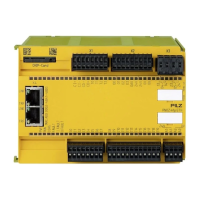Electromagnetic compatibility (EMC)
Installation Manual PNOZmulti Installation Manual
1002265-EN-02
10
3 Electromagnetic compatibility (EMC)
3.1 Overview
The PNOZmulti systems are designed for use within an electromagnetic industrial environ-
ment. To ensure electromagnetic compatibility the correct procedures must be carried out
during installation.
A device is electromagnetically compatible if
} It functions without error in a given electromagnetic environment.
} It does not adversely affect its own environment.
Electromagnetic interference can reach the devices through:
} Fields
} Power supplies
} Earth cabling
} Bus connections
} Interfaces
} Input and output cables
The interference can be transferred from the source to the receiver (interference sink) via
the coupling routes.
Interference reaches the interference sink (e.g. the control system devices) in various ways:
} DC coupling:
DC coupling occurs if the source and sink of interference have common cable connec-
tions. The common cable presents complex resistances, inducing potential differences.
– Typical sources of interference are switches/relays, running motors or varying po-
tentials for other systems on the same power supply.
} Capacitive (electrical) coupling
A different potential between the source and interference sink (e.g. two cables) creates
an electrical field. Coupling is proportional to the rate of voltage change.
– Typical sources of interference are contactors, static discharge, parallel signal
cables.
} Inductive (magnetic) coupling
A live cable produces a magnetic field which also surrounds adjacent cables. Interfer-
ence voltage is induced. Coupling is proportional to the rate of current change.
– Typical sources of interference are mains cables running in parallel, live cables,
high frequency cables, inductors, transformers, motors.
} Electromagnetic coupling
A cable can emit a signal as a radio wave. This wave is then picked up by another
cable.
– Typical sources of interference are transmitters such as radios, sparks from spark
plugs, welding equipment, etc.

